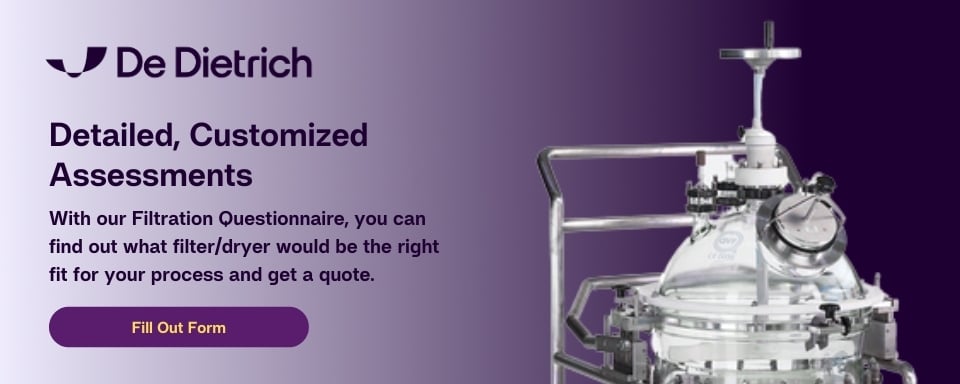Centrifugation vs Filtration: Product Comparison for Solid-Liquid Separation
 There are several filtration technologies used in industrial processes for solid-liquid separation. In most cases, the solid that is obtained is the desired product, although in some instances the filtered liquid is the valued product.
There are several filtration technologies used in industrial processes for solid-liquid separation. In most cases, the solid that is obtained is the desired product, although in some instances the filtered liquid is the valued product.
Regardless of what material you are looking to harvest or whether your process runs as a continuous or batch, choosing the right separation technology can feel overwhelming.
Since the type of material being separated can vary by particle size, density and other application-specific details, there is not a “one size fits all” design.
Two of the most prevalent separation technology solutions are centrifuges and filter-dryers, both widely used for industrial solid-liquid separation.
In this post, we’ll compare centrifugation vs filtration, define each technology, and outline key advantages and limitations to help you evaluate which method best fits your process requirements.
Relevant Industries Using Centrifugation and Filtration
Before we dive into equipment basics, it’s worth understanding where these technologies are most often applied. The six most prominent industries that utilize large-scale separation equipment are:
- Wastewater Processing – separation of suspended solids, toxic heavy metals, and fatty organic materials
- Chemical Processing – filtration of acids, salts, and polymers
- Pharmaceutical & Biotechnology – production of drugs, active pharmaceutical ingredients (APIs), vaccines and medicines
- Fuel & Biofuel – processing of ethanol, synthetic fuels, and biodiesel
- Food Processing – refining vegetable oils, dairy products, and alcohol
- Mining & Mineral Processing –purifying coal, tar sands, and precious metals
These examples show the widespread use of both centrifuges and filter-dryers across industries requiring large-scale solid-liquid separation.
What Is Centrifugation?
A centrifuge operates on the principle of centrifugal force – the outward force created by high-speed rotation. The objective of this equipment is to separate, extract and wash products in either a continuous or discontinuous (batch) operation using high-speed gravitational pull generated from the rapid RPMs.
The filtered product then falls to the bottom of the centrifuge where it is discharged from the vessel.
Industrial centrifuges fall into two main categories: sedimentation and filtering centrifuges. Our focus is on filtering centrifuges, which use the centrifugal force to pass a liquid through filtration media (such as wire mesh or cloth) while retaining solids.
Filtering centrifuges are further divided into:
- Perforate basket centrifuges – similar to washing machine design
- Pusher centrifuges – horizontal-axis “moving bed” continuous discharge
- Peeler centrifuges – batch or continuous operation with a peeler knife for complete product discharge
What Is Filtration with a Filter-Dryer?
The filter-dryer is another logical choice in the quest for equipment that provides efficient filtration suited for critical, high-purity separations.
As with centrifuges, there are various types of filters available, a prime example being Nutsche filter-dryers, which employ a batch filtration using vacuum and/or pressure in a closed vessel. The filter plate, fitted with the appropriate media, allows liquid to pass through while forming a solid bed (“cake”). The basic steps of Nutsche filtration include:
- Filling/Charging

- Filtering
- Displacement Washing
- Reslurry Washing
- Smoothing
- Drying/Cooling
- Discharging
This closed, pressure-tight system provides safe, controlled separations, making filter-dryers ideal for high-purity, toxic, or solvent-sensitive materials..
Centrifugation vs Filtration: Pros and Cons
Now that we’ve outlined the basics, how do these technologies measure up? Below is a centrifugation vs filtration product comparison based on common decision factors:
Containment
Winner: Filter-Dryer
A filter-dryer is totally enclosed and pressure tight (rated to 50 psig/FV at a minimum), protecting operators and the environment. The closed system makes them ideal for high purity, toxic, or flammable materials.
Maintenance and Operational Costs
Winner: Filter-Dryer
With no high-speed components and a low motor horsepower, filter-dryer reduces both maintenance and operational costs compared to centrifuges. Additionally, the agitator is only used during drying, smoothing, reslurry washing, and discharge, whereas a centrifuge motor is always in operation.
Reduced Moisture Content of Wet Cake
Winner: Centrifuge
Centrifuges achieve lower moisture content in wet cake, with typical LOD (limit of detection) difference of 5% to 10% (depending on time and product). This data assumes there is no extended blow through in the filter.
Washing Efficiency
Winner: Filter-Dryer
A filter-dryer allows for extended residence time during displacement washing with the added capability of a reslurry washing, using a reduced amount of wash fluid to effectively complete this step).
Capacity Flexibility
Winner: Filter-Dryer
Although centrifuges and filter/dryers are available in roughly the same size range, filter-dryers enable possible increased capacity as the units are typically sized to handle the entire batch solids load.
Handling Extremely Difficult Products
Winner: Centrifuge
Especially for compressible cakes, centrifuges promise better results than separation in conventional filter-dryers. In the context of centrifugation vs filtration, centrifuges also prove to be a good solution for cakes not suitable for deep bed filtration.
Discharge Capabilities
Winner: Tie
When it comes to discharging capabilities, both centrifuges and filter-dryers offer their own unique advantages. For complete product discharge, a filter/dryer has some heel associated with agitator to vessel tolerances whereas a centrifuge allows for complete discharge (though this can depend on the centrifuge design). Filter-dryers specialize in flexible discharge which enables the expulsion of dry solids, wet solids, slurries, or liquid.
In short, depending on your discharge objectives one type of equipment may be more advantageous to you than the other.
Drying Capability
Winner: Filter-Dryer
With “dryer” as part of its name, it’s no surprise that the filter-dryer takes the lead in this category. Utilizing vacuum or blow through drying, the filter-dryer makes it possible to obtain completely dry material out of the filter, which reduces overall process time.
Live Load
Winner: Filter-Dryer
There is no live load associated with the filter-dryer thanks to the low RPM agitator (8-20 RPM on average), resulting in lower installation costs compared to centrifuges.
FAQs: Centrifugation vs Filtration
Q: What is the difference between centrifugation and filtration?
A centrifuge uses centrifugal force to separate solids and liquids, while filtration relies on pressure or vacuum through a filter medium.
Q: When should I choose a centrifuge over a filter-dryer?
Centrifuges are better for compressible cakes and applications needing lower moisture content.
Q: When is a filter-dryer the better option?
Filter-dryers are ideal for high-purity, toxic, or solvent-sensitive products, offering enclosed containment and drying capabilities.
Which Separation Technology Should You Choose?
While filter-dryers appear to win more categories in this centrifugation vs filtration comparison, the best choice depends on your application requirements. Factors such as particle size, compressibility, moisture content, and operational goals must be evaluated carefully.
Both centrifuges and filter-dryers have their place in modern solid-liquid separation technology. Choosing the right one requires aligning process requirements with equipment capabilities.
De Dietrich has an online Filtration Questionnaire that will give you a complimentary assessment to help determine a solution for your separation requirements.
